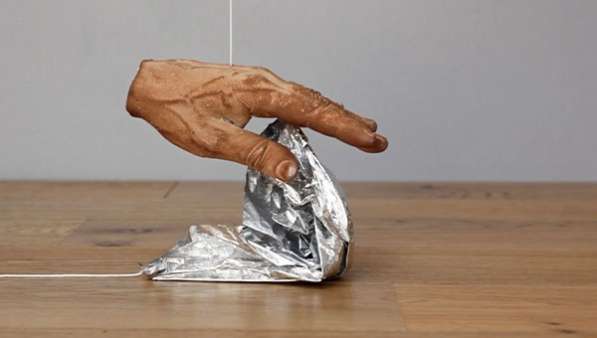JC Ruggirello
Lingua Mortafrom September 3 to September 24 - 2022
print
JC Ruggirello
Lingua Morta
September 3 - 24, 2022
Opening Saturday September 3rd
Seeking to situate himself in time and space, Jean-Claude Ruggirello uses all the possibilities that the technique of assembly offers him. He believes no image is more interesting than another. It’s more about the space that they generate between themselves that counts rather than what they show. All kinds of material find favor in his eyes and anything can be used. What is important are the connections, the mixtures that the sculptor produces.
Anne-Laure Boyer in Gestes, traces et autres signes, Frac Provence-Alpes-Côte d'Azur, 2005.
They were performance-based videos, in the sense that they staged, in a complex space, insignificant actions, without an apparent goal, often repetitive and marked by a kind of stupidity but also by difficulty. Digging deeper, I saw that the artist was indeed constructing numerous works in volume and of every dimension. [...] Works that poetically affirm the discontinuity of the lines of force that run through the world and the instability that results from it, but that also abundantly cite the history of art and the processes that develop it.
Alain Berland in JC Ruggirello, Ed. Analogues, 2011.
Several of the video installations confirmed that what interests Ruggirello is the ability of the moving image to produce sculpture or, more generally, forms rather than its capacity to create narrative or imagery. One of the few French video artists whose work could be seen in relation to Jack Goldstein's films from the second half of the 1970s.
In 20 ans d'art en France, Une histoire sinon rien, 1999-2018, edited by Michel Gauthier and Marjolaine Lévy, Ed. Flammarion, 2018.
His research is characterized by a quest for simplicity, which sometimes involves the accumulation of forms to reach their limit and, in effect, their excess. Whether it is two kayaks folded in the middle and presented like two recumbent effigies two meters above the ground, entire trees freshly uprooted and filmed in rotation in perfect horizontal balance, various machines with rudimentary mechanics or projection devices, whatever the materials, the artist's work is always built on a striking visual surprise that ultimately extracts an infinite number of poetic readings.
Gaël Charbau, 2020.
Jean-Claude Ruggirello is known for his sculptures and videos as well as his sound and visual environments. He has the distinction of conceiving the treatment of the image, whatever its support, in a sculptural dimension and in its relation to space. Between control and accident, he plays with the necessary brutality of the sculptor's movements, by biting, piercing, tearing, burning the material. At the same time, he defies it, because he pays attention and "converts" these situations, these objects or materials of everyday life and makes them unusual and poetic.
Valentine Meyer in open-ring.com, 2021.
Rare but decisive are those who manipulate sculptures, constantly turning them upside down. The Rodin in Meudon with its series of plaster models that can be endlessly reassembled. Rosso who shifts sculpture by making moulding wax the only material for his sculpture, even if it means that it melts with time. West and his portable sculptures that extend certain parts of the body. Calder and his Grand Cirque so well shot by Jean Painlevé that the film gives a better understanding of the work than the small sculptures that remain. Finally, Ruggirello, who uses waste from the workshop and reanimates it on film. With these artists, there is never the imposing presence of sculpture. They have succeeded, each one in their way, to work around it. Jean-Claude Ruggirello interests us in the sense that he intervenes in the field of our social body and illustrates it. He explains it. He is concerned by the off-field, the blind spot of the sculpture, which has sought to impose itself by its mass and the space which it has monopolized and yet has fled from it. On the contrary, with Ruggirello, sculpture escapes in favor of a becoming-minority according to Deleuze. It tries to reinvent itself, escaping from itself, abandoning its privileges, inventing "a dialectal, minority, non-hegemonic language", as he says. Thus, he recovers scattered objects, usual objects like worn out words, manufactured according to long established standards, since antiquity simply put, to transform them, to knead them, in sculptures, in a new vocabulary. One just has to follow the avatars of his glass of water filmed throughout his journeys to see it close up.
Eric Fabre, 2022.
---------------------------
JC Ruggirello - born in 1959 in Tunis, lives and works in Paris.
After studying at the Beaux-Arts in Marseille and the Hochschule für Bildende Kunst in Hamburg in the early 1980s, JC Ruggirello has regularly exhibited in France and abroad (Swiss Institute, New York; MUHKA, Antwerp; Musée des Beaux-Arts, Dijon; Frac Aquitaine, Bordeaux; Musée des Beaux-Arts, Nantes). He has had several major solo exhibitions, notably at the Frac PACA and the Centre d'Art Contemporain de Neufchâtel (2000) and at the Creux de l'Enfer, Thiers (2004).
His videos have been selected for international festivals and presented in many venues (MAXXI Rome, Fresnoy, Pernod Ricard Foundation, International Film Festival Rotterdam, Nam June Paik Art Center South Korea, Maeght Foundation).
His works have been included in numerous public collections as well as important private collections. Since 1999, he has taught at the Beaux-arts in Marseille. The Galerie Papillon has represented his work since the beginning of the 2000s.
In 2022, Ruggirello participated in the exhibition Végétal. L'école de la beauté organized by Chaumet at the Palais des Beaux-Arts in Paris. A text on Ruggirello by Mihnea Mircan will be published on the Pernod Ricard Foundation’s TextWork platform.